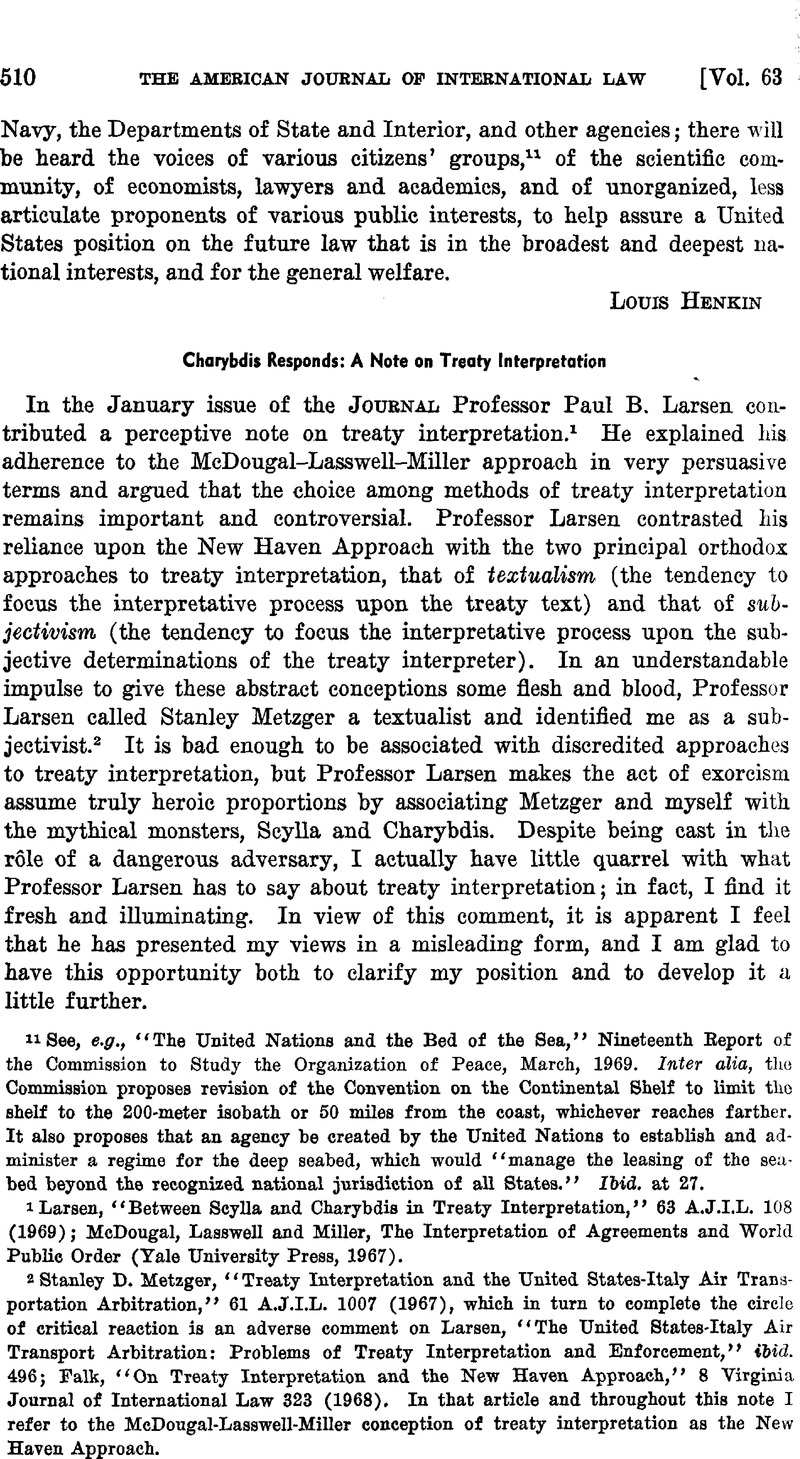No CrossRef data available.
Article contents
Charybdis Responds: A Note on Treaty Interpretation
Published online by Cambridge University Press: 28 March 2017
Abstract

- Type
- Editorial Comment
- Information
- Copyright
- Copyright © The American Society of International Law 1969
References
1 Larsen, “Between Scylla and Charybdis in Treaty Interpretation,” 63 A.J.I.L. 108 (1969); McDougal, Lasswell and Miller, The Interpretation of Agreements and World Public Order (Tale University Press, 1967).
2 Stanley D. Metzger, “Treaty Interpretation and the United States-Italy Air Transportation Arbitration,” 61 A.J.I.L. 1007 (1967), which in turn to complete the circle of critical reaction is an adverse comment on Larsen, “The United States-Italy Air Transport Arbitration: Problems of Treaty Interpretation and Enforcement,” ibid. 496; Falk, “On Treaty Interpretation and the New Haven Approach,” 8 Virginia Journal of International Law 323 (1968). In that article and throughout this note I refer to the McDougal-Lasswell-Miller conception of treaty interpretation as the New Haven Approach.
3 There is some ambiguity in Professor Larsen.'s characterization of my approach in the second paragraph of p. 109 in his piece, where he mixes the contingent syntax of “may” with the unconditional syntax of “must.” My intention was to be contingent, namely, to point out that an interpreter may be faced with problems, not that the process of interpretation is necessarily arbitrary in character. In fact, I think that the New Haven Approach, if used in a genuine fashion, can illuminate these issues of interpretative choice far better than can alternative modes of interpretation.
4 This point is effectively made in an exceedingly important appraisal of the New Haven Approach and treaty interpretation by Gidon Gottlieb, “The Conceptual World of the Tale School of International Law,” 21 World Politics 108-132, 127 (1968) (hereinafter cited as Gottlieb). Professor Gottlieb demonstrates that, just as rules arise in complementary pairs, a point McDougal has often emphasized, so do world community policies.
5 See John’s. Hannon, Jr., ” A Political Settlement for Vietnam: The 1954 Geneva Conference and Its Current Implications,” 8 Virginia Journal of International Law 4 (1968). Mr. Hannon's analysis is carried out in the tradition of the New Haven Approach and does illuminate many aspects of the agreements, but note the shift in emphasis from the agreements reached to the conference milieu. Such a shift carries contextualism, in my judgment, too far and raises certain doubts about the persuasiveness of the specific interpretations proposed, especially of Hannon's conclusions that are quite at variance with the rather clear textual formulations in Arts. 6 and 7 of the Final Declaration of the Geneva Conference.
6 Gottlieb, loc. tit., esp. pp. 112-120.
7 See Book Review, 117 University of Pennsylvania Law Beview 647-664 (1969).
8 See Bums Weston, “Special Book Review—L''Affaire Sabbatino: A Wistful Review,” 55 Kentucky Law Journal 844, 853-857 (1967).
9 McDougal, Lasswell and Miller, pp. 88-111, esp. 100-111.
10 Cf. Philip Green, The Deadly Logic (Ohio State Press, 1966), who makes a comparable argument with respect to the suppressed policy preferences embedded in the nuclear strategy debate. Professor Green shows that nuclear strategists used an objective rhetoric as a very effective instrument of persuasion in support of subjective views.


